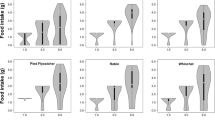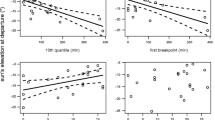Abstract
Migratory restlessness has been studied intensively in bird species that migrate nocturnally. However, such studies are rare for diurnal migrants. For the first time, we used a twin activity recording design to study the migratory restlessness of a diurnal migrant, the Linnet Carduelis cannabina, by distinguishing foraging activity from possible migratory activity. Hand-reared naïve Linnets kept under controlled indoor conditions with a constant photoperiod showed significantly increased diurnal activity, body mass and feeding activity during the autumn migratory period of wild conspecifics. Nocturnal activity was absent. These results imply that diurnal short- to medium-distance migratory songbirds possess endogenous control over their migratory behaviour, similar to nocturnal migrants. Compared to long-distance nocturnal migrants, the seasonal increases in body mass of the Linnets were moderate, likely reflecting their shorter migration routes, which are traversed as a series of short flights with plenty of foraging opportunities en route.
Zusammenfassung
Endogenes Zugverhalten bei einem tag-ziehenden Singvogel
Zugunruhe als Ausdruck endogenen Zugverhaltens wurde bisher überwiegend an obligaten nachts ziehenden Arten untersucht. Untersuchungen an tagsüber ziehenden Arten sind dagegen selten. Zum ersten Mal verwendeten wir einen zweifachen Messansatz, um die Zugaktivität eines Tagziehers, dem Bluthänfling Carduelis cannabina zu untersuchen, wobei wir Aktivität zur Nahrungssuche von möglicher Zugaktivität getrennt aufgezeichnet haben. Von Hand aufgezogene, naïve Bluthänflinge zeigten in konstanten photoperiodischen Bedingungen im Labor dann signifikant erhöhte Tagaktivität, Körpermasse und Fressaktivität, wenn freilebende Vögel ihren herbstlichen Zug machen. Nächtliche Aktivität wurde nicht beobachtet. Dies zeigt, dass tags ziehende Kurz- und Mittelstreckenzieher über eine ähnliche endogene Kontrolle ihres Zugerhaltens verfügen, wie sie von Nachtziehern beschrieben ist. Im Vergleich zu nachts ziehenden Langstreckenziehern war die saisonale Zunahme der Körpermasse moderat, was wohl den kürzeren Zugweg wie auch die Tatsache widerspiegelt, dass Bluthänflinge in einer Serie von kürzeren Zugetappen ziehen mit vielfältigen Möglichkeiten zu Rast und Fressen unterwegs.


Similar content being viewed by others
References
Alerstam T, Lindström Å (1990) Optimal bird migration: The relative importance of time, energy and safety. In: Gwinner E (ed) Bird migration. Springer, Berlin, pp 331–351
Babushkina O, Bojarinova J (2011) Photoperiodically regulated cycle of locomotory activity and fat reserves during migration seasons in the irruptive bird species, the long-tailed tit Aegithalos c. caudatus. J Avian Biol 42:169–177
Bairlein F (1995) Manual of field methods: European-African songbird migration network. Inst Vogelforschung, Wilhelmshaven
Bairlein F, Gwinner E (1994) Nutritional mechanisms and temporal control of migratory energy accumulation in birds. Annu Rev Nutr 14:187–215
Bairlein F, Dierschke J, Dierschke V, Salewski V, Geiter O, Hüppop K, Köppen U, Fiedler W (2014) Atlas des Vogelzugs. Ringfunde deutscher Brut- und Gastvögel. AULA, Wiebelsheim
Bauer HG, Bezzel E, Fiedler W (2005) Das Kompendium der Vögel Mitteleuropas. Band 2: Passeriformes—Sperlingsvögel. 2. Auflage. AULA, Wiebelsheim
Berthold P (1976a) Über den Einfluss der Fettdeposition auf die Zugunruhe bei der Gartengrasmücke Sylvia borin. Vogelwarte 28:263–266
Berthold P (1976b) Über den Einfluß der Fettdeposition auf die Zugunruhe bei der Gartengrasmücke (Sylvia borin). Vogelwarte 28:263–266
Berthold P (1977) Über die Entwicklung von Zugunruhe bei der Gartengrasmücke (Sylvia borin) bei verhinderter Fettdeposition. Vogelwarte 29:113–116
Berthold P (1978) Die quantitative Erfassung der Zugunruhe bei Tagziehern: Eine Pilotstudie an Ammern (Emberiza). J Ornithol 119:334–336
Berthold P (1984) The endogenous control of bird migration: a survey of experimental evidence. Bird Study 31:19–27
Berthold P (1988) Evolutionary aspects of migratory behaviour in European warblers. J Evol Biol 1:195–209
Berthold P (1996) The control of bird migration. Chapman & Hall, London
Berthold P (2000) Vogelzug. Eine aktuelle Gesamtübersicht. 4. Auflage. Wissenschaftliche Buchgesellschaft, Darmstadt
Berthold P, Querner U (1981) Genetic basis of migratory behaviour in European warblers. Science 212:77–79
Berthold P, Gwinner E, Klein H (1970) Vergleichende Untersuchung der Jugendentwicklung eines ausgeprägten Zugvogels, Sylvia borin, und eines weniger ausgeprägten Zugvogels, S. atricapilla. Vogelwarte 25:297–331
Berthold P, Fiedler W, Querner U (2000) Die Zugunruhe bei Vögeln—eine Darstellung nach Videoaufnahmen bei Infrarotlichtbeleuchtung. J Ornithol 141:285–299
Berthold P, Wiltschko W, Miltenberger H, Querner U (1990) Genetic transmission of migratory behavior into a non-migratory bird population. Experientia 46:107–108
Bojarinova J, Babushkina O (2015) Photoperiodic conditions affect the level of locomotory activity during autumn migration in the Long-tailed Tit (Aegithalos c. caudatus). Auk 132:370–379
Bulte M, Bairlein F (2013) Endogenous control of migratory behaviour in Alaskan Northern Wheatears Oenanthe oenanthe. J Ornithol 154:567–570
Castelli M (1988) Contribution à la phénologie de migration et à la biométrie du verdier d’Europe Carduelis chloris (Linné, 1758) et de la linotte mélodieuse, Carduelis cannabina (Linné, 1758). Cahiers d’Ethologie Appliquée 8:501–582
Cornelius JM, Hahn TP (2012) Seasonal pre-migratory fattening and increased activity in a nomadic and irruptive migrant, the Red Crossbill Loxia curvirostra. Ibis 154:693–702
Csorgo M, Horvath L (1997) Limit theorems in change-point analysis. Wiley, New York
Dierschke J, Dierschke V, Hüppop K, Hüppop O, Jachmann KF (2011) Die Vogelwelt der Insel Helgoland. OAG Helgoland, Helgoland
Dorka V (1966) Das jahres- und tageszeitliche Zugmuster von Kurz- und Langstreckenziehern nach Beobachtungen auf den Alpenpässen Cou/Bretolet (Wallis). Ornithol Beobachter 63:165–223
Eikenaar C, Bairlein F (2014) Food availability and fuel loss predict Zugunruhe. J Ornithol 155:65–70
Eikenaar C, Klinner T, Szostek KL, Bairlein F (2014) Migratory restlessness in captive individuals predicts actual departure in the wild. Biol Lett 10:20140154
Förschler MI, Del Vale E (2009) Farbberingte Bluthänflinge Carduelis cannabina auf Helgoland—einmal Spanien und zurück. Ornithologischer Jahresbericht Helgoland 19:106–107
Funnell JR, Munro U (2010) Daily and seasonal activity patterns of partially migratory and nonmigratory subspecies of the Australian silvereye, Zosterops lateralis, in captivity. J Ethol 28:471–482
Gartrell BD, Jones SM (2012) No evidence for synchrony of physiological or behavioural preparations for migration in a short-distance migratory parrot. Emu 112:1–8
Gatter W (2000) Vogelzug und Vogelbestände in Mitteleuropa—30 Jahre Beobachtung des Tagzugs am Randecker Maar. AULA, Wiebelsheim
Glück E (1978) Aktivitätsuntersuchungen an Tagziehern (Carduelis carduelis). J Ornithol 119:336–338
Glück E (1982) Locomotor activity of day-migrating finches. In: Papi F, Wallraff HG (eds) Avian navigation. Springer, Berlin, pp 90–95
Glutz von Blotzheim UN, Bauer KM (1997) Handbuch der Vögel Mitteleuropas Band 14/II. Passeriformes (5. Teil): Fringillidae—Parulidae. AULA, Wiesbaden
Gwinner E (1977) Circannual rhythms in bird migration. Annu Rev Ecol Evol Syst 8:381–405
Gwinner E (1986) Circannual rhythms. Springer, Heidelberg
Gwinner E (2003) Circannual rhythms in birds. Curr Opin Neurobiol 13:770–778
Helbig A, Laske V (1986) Zehnjährige Planbeobachtungen des herbstlichen Vogelzugs in Ostwestfalen: status, Zugzeiten und Häufigkeit der einzelnen Arten. Ber Naturwiss Verein Bielefeld und Umgebung 28:273–300
Helm B (2006) Zugunruhe of migratory of migratory and non-migratory birds in a circannual context. J Avian Biol 37:533–540
Hölzinger J (1997) Die Vögel Baden-Württembergs Band 3.2: Singvögel 2. Passeriformes—Sperlingsvögel: Muscicapidae (Fliegenschnäpper) und Thraupidae (Ammertangaren). Eugen Ulmer GmbH & Co., Stuttgart
Kaiser A (1993) A new multi-category classification of subcutaneous fat deposits of songbirds. J Field Ornithol 64:246–255
Killick R, Eckley IA (2014) Changepoint: an R package for changepoint analysis. J Stat Softw 58:1–19. http://www.jstatsoft.org/v58/i03/
Lundberg P (1981) Migratory restlessness in caged Bramblings Fringilla montifringilla in northern Sweden. J Ornithol 122:65–72
Maggini I, Bairlein F (2010) Endogenous rhythms of seasonal migratory body mass changes and nocturnal restlessness in different populations of Northern Wheatear Oenanthe oenanthe. J Biol Rhythms 25:268–276
Munro U, Munro JA (1998) Migratory restlessness in the Yellow-faced Honeyeater Lichenostomus chrysops (Meliphagidae), an Australian diurnal migrant. Ibis 140:599–604
Newton I (2008) The ecology of bird migration. Academic, London
Palmgren P (1943) Zur Tagesrhythmik der Finkenvögel. Ornis Fenn 20:99–103
Piersma T, Perez-Tris J, Mouritsen H, Bauchinger U, Bairlein F (2005) Is there a “migratory syndrome” common to all migrant birds? Ann N Y Acad Sci 1046:282–293
Pohl H, West GC (1976) Latitudinal and population specific differences in timing of daily and seasonal functions in redpoll (Acanthis flammea). Oecologia 25:211227
Pulido F, Berthold P (2003) Quantitative genetic analysis of migratory behaviour. In: Berthold P, Gwinner E, Sonnenschein E (eds) Avian migration. Springer, Heidelberg, pp 53–77
R Development Core Team (2014) R: a language and environment for statistical computing. R Foundation for Statistical Computing, Vienna. http://www.R-project.org
Ramenofsky M, Cornelius JM, Helm B (2012) Physiological and behavioral responses of migrants to environmental cues. J Ornithol 153(Suppl 1):S181–S191
Watts HE, Robart AR, Chopra JK, Asina CE, Hahn TP, Ramenofsky M (2017) Seasonal expression of migratory behavior in a facultative migrant, the pine siskin. Behav Ecol Sociobiol 71(1):1–12. doi:10.1007/s00265-016-2248-2
Weise G (1963) Annual physiological cycles in captive birds of differing migratory habits. In: Sibley CG (ed) Proceedings of the XIII International Ornithological Congress. Allen, Lawrence, pp 983–993
Zehnder S, Karlsson L (2001) Do ringing numbers reflect true migratory activity of nocturnal migrants? J Ornithol 142:173–183
Zink G, Bairlein F (1995) Der Zug europäischer Singvögel, vol 3. AULA, Wiesbaden
Acknowledgements
We thank Ulrich Meyer and Adolf Völk for animal husbandry, Timo Ubben for technical support, and Jochen Dierschke and his team at the field station on Helgoland for their support on the island. Cas Eikenaar provided useful comments about an earlier version of the manuscript.
Author information
Authors and Affiliations
Corresponding author
Additional information
Communicated by L. Fusani.
Rights and permissions
About this article
Cite this article
Stey, K., Röseler, D. & Bairlein, F. Endogenous migratory behaviour in a diurnally migrating songbird. J Ornithol 158, 717–724 (2017). https://doi.org/10.1007/s10336-017-1440-0
Received:
Revised:
Accepted:
Published:
Issue Date:
DOI: https://doi.org/10.1007/s10336-017-1440-0




